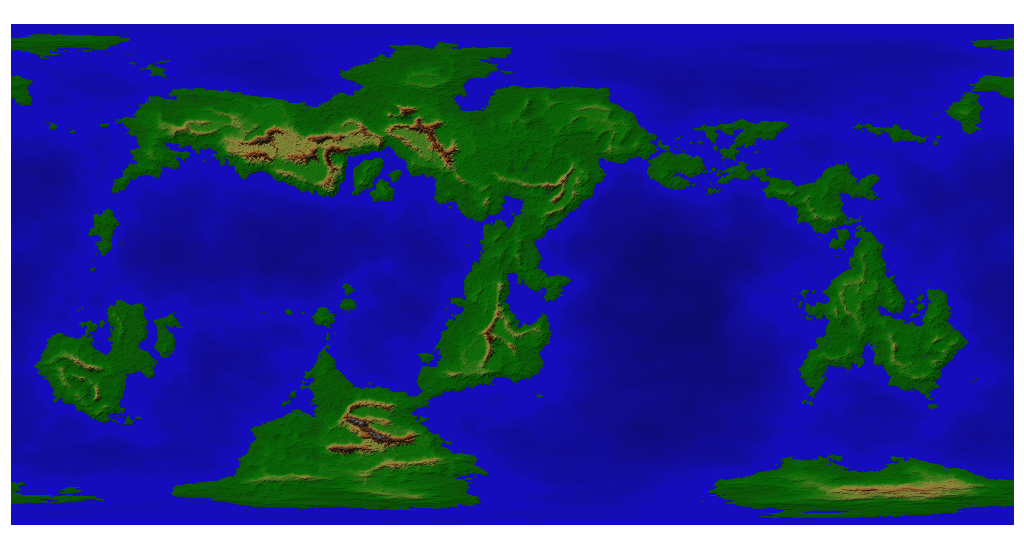WIP: Aiyedjembe
I've been working on this world in Fractal Terrains for a few months, and have probably about 50 or so outputs to show for it. Been playing around with the heights and climate. Anyway, I think I'm mostly settled on the altitudes in the png I've attached. I decided to do temperature and rainfall maps from scratch, using some basic things I've taught myself about climate. It seems like you can only put one attachment at a time in here, so I'll attach the temperature map in another post. Wondering how people feel about my progress.
Thanks,
Autumn
Thanks,
Autumn



Comments
Are you going to be translating this to CC3 next, or continuing in FT3 for a while yet?
Thanks for the compliment.
A.
There is a book about how to work these things out, but I'm dashed if I can remember the title right now. Its one of those 1-2-3 type books that takes you through the whole process.
Once you've worked it out you can amend the temperature and rainfall maps by painting the corrected values onto your world (by hand).
I'll just go and see if I've got a record of that title somewhere...
Here it is!
Geoff's Climate Cookbook
Its more of a couple of pages rather than a book, and I've never had the time to work out a whole planet, but its helped a lot when doing a bit of quick mental calculation on where things like deserts might be.
I've already spent a lot of time with Geoff's cookbook, and then a few interesting tutorials that were built off it at Cartographer's Guild. I actually came up with about eight different techniques to model the climate of the world, and then decided to just rebuild the rainfall and temperature maps according to some basic earth principles, with reference to some maps I found online. So I set up a basic bar approach for the temperature, with four different temperatures, and then created intermediate areas that were dependent on ocean currents, so that where ocean currents went the temperature would be modified. I then smoothed the final result at several different values, comparing each one to the real world map. The temperature map I posted was smoothed at a value of 150, and I feel is fairly close to the earth's (but I'm open to hear countering opinions).
I am about half way through a rainfall map using similar techniques, although of course its a whole lot more complicated.
The reason I want to do worldwide climate is I want to simulate migration on the planet to determine where cultures are.
Any thoughts?
And thanks for hunting that down for me, even if I had already seen it.
A.
I've included a png with my settings here. It didn't come out exactly like this. I kept changing the north pole until I got an arrangement which fit most of the map in a centered set up rather than being cut up by the edges. I didn't actually find the best set up right away, but I had done a lot of work so I accepted it. Every time I open up FT, it loads these settings and gives me a new map, and most of them are pretty fantastic and amenable to good centering. I've saved about thirty different worlds and even done full climate workups for one of them. I'd be happy to throw you a few files if you like.
For curiosity's sake, I'll just mention that this is 0 N 130 E, while the best fit is actually 30 N 118 E, if I recall correctly. I actually did a lot of experimenting with pole positioning, as I was exploring the idea it could be used to simulate continental drift. It was fun, and I came up with some cool alternate maps, but ended up returning to this one.
As a caution, if you do fool with the poles, settle on the final position before doing time-consuming incisions, as they often become undone. Also, do your best to keep land off the 180 as this will give you profound incisions you don't want. I do know how to fix them though, if you have trouble.
I could go on all day about FT, I really do love that program and learned how to do some fun stuff in it.
A.
Get better soon, Autumn.
Autumn
I also looked at the river system in the prairie provinces of Canada, which are quite dry. Medicine Hat gets 20 mm apparently.
I'm still uncomfortable with it. One thing I thought of doing is raising precipitation around rivers by 20 mm, which it looks like wouldn't disturb the general climatic pattern and also adds a bit more complexity to the zones. I really don't want to lose too much desert though, as there's not much of it to begin with.
Interestingly, the river system is about the same length as the Colorado, and does have its start in mountains, even if they're quite low.
I guess I could just not put in some of the rivers when I do regional mapping.
Sorry, I'm rambling.
As a relevant aside, I was looking at applying Koppen classifications here, and technically some of the northernmost desert, and much of the chapparal region in between the deserts, actually would qualify as cold steppe and as humid -- mostly because of the low temperatures of those regions. On a world map it corresponds to the northern part of the Eurasian steppes and into the Russian plains/boreal region.